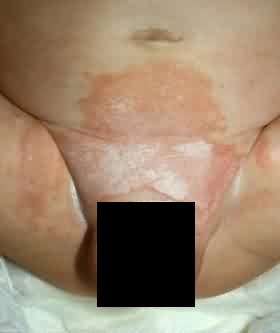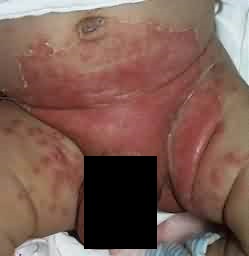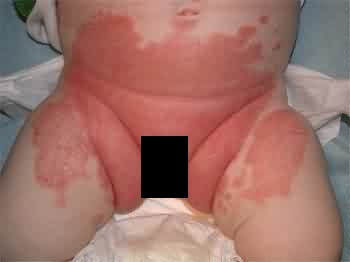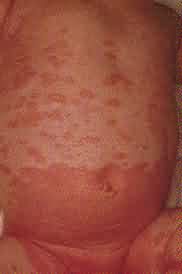Friction or irritation
This is the commonest cause of diaper rash, most commonly on areas where the diapers rub against the skin, fit too tightly or are left on for too long, such as the inner thighs, or under the elastic of diapers.
These rashes usually get better easily with frequent diaper changes and airing of the diaper area.
Contact dermatitis
Causes

This rash is mostly found on the exposed areas, such as the round part of the buttocks. It tends to spare skin folds and creases. May be caused by :
- prolonged contact with urine or faeces.
- sensitivity to chemicals and disposable diapers
- detergent used in laundering cloth diapers
Treatment
- The best treatment is frequent diaper changes and by protection of the skin with a barrier product containing zinc oxide.
- The skin should be cleansed with warm water after voiding or stooling.
- Change your baby’s diaper often, and let him go without a diaper when possible to let the air dry his or her skin.
- Cornstarch should not be used as they provide a media for growth of bacteria and yeast.
- Talcum powder should be avoided as it can get into baby’s lungs and cause breathing problems.
Prevention
The key to preventing and treating diaper rash is to keep your baby’s diaper area clean, cool and dry.
- Check your baby’s diaper often and change it as soon as it’s wet or soiled.
- Carefully clean your baby’s bottom between diaper changes. Use plain warm (not hot) water with or without a very mild soap.
- Allow your baby’s skin to dry completely before putting on another diaper.
- Use products that contain zinc oxide ointment to protect your baby’s skin.
- Avoid using plastic pants or diaper covers as far as possible.
- Avoid diaper wipes that contain alcohol.
- If diaper rash persists, change the type of wipes, diapers or soap you’re using.
Candida diaper rash

- A fungal infection of skin in the diaper area may include buttocks, groin, thighs and abdomen.
- It is caused by the organism Candida albicans which thrives in warm wet areas.
- It appears as a moist red rash often with white or yellow satellite pustules, and can in more severe cases, can have a beefy red appearance.
- It can be easily distinguished from contact dermatitis as the rashes involve the creases.
Treatment
Treatment consists of :
- Antifungal cream or ointment, such as nystatin, applied to the rashes several times per day.
- Air drying the area.
- Apply zinc oxide cream over the antifungal cream.
See a doctor if :
- The diaper rash occurs in the first 6 weeks of life.
- Pimples and small ulcers form.
- Your baby has a fever.
- Your baby loses weight or isn’t eating as well as usual.
- Large bumps or nodules appear.
- The rash spreads to other areas, such as the arms, face or scalp.
- The rash doesn’t get better after trying the tips on treating diaper rash for 1 week.
Seborrheic dermatitis
Signs and symptoms
- Due to an excessive production of oil or sebum by the skin’s oil-producing sebaceous gland.
- Red patches with greasy scaly rash.
- Found shortly after birth in areas of the body which contain the most sebaceous glands and may involve the scalp (cradle cap), behind the ears, groin, axilla and leg creases.
- Sometimes, if severe enough, this rash can ooze.
- There may be secondary infection.
- There may be scaly skin on the eyebrows, face and scalp.
Treatment
- Weak topical steroid creams, if necessary, is helpful.
- The scalp normally responds to shampoos or the use of olive oil to soften the scales.
 |
 |
| Last reviewed | : | 28 August 2020 |
| Content Writer | : | Dr. Irene Cheah Guat Sim |
| Dr. Terrence Thomas | ||
| Dr. Umathevi Paramasivam | ||
| Reviewer | : | Dr. Zainab bt. Kusiar |







